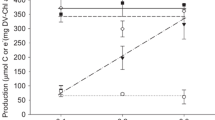Abstract
The effects of light intensity, oxygen concentration, and pH on the rates of photosynthesis and net excretion by metalimnetic phytoplankton populations of Little Crooked Lake, Indiana, were studied. Photosynthetic rates increased from 1.42 to 3.14 mg C·mg−1 chlorophylla·hour−1 within a range of light intensities from 65 to 150μE·m−2·sec−1, whereas net excretion remained constant at 0.05 mg C·mg−1 chlorophylla·hour−1. Bacteria assimilated approximately 50% of the carbon released by the phytoplankton under these conditions. Excreted carbon (organic compounds either assimilated by bacteria or dissolved in the lake water) was produced by phytoplankton at rates of 0.02–0.15 mg C·mg−1 chlorophylla·hour−1. These rates were 6%–13% of the photosynthetic rates of the phytoplankton. Both total excretion of carbon and bacterial assimilation of excreted carbon increased at high light intensities whereas net excretion remained fairly constant. Elevated oxygen concentrations in samples incubated at 150μE· m−2·sec−1 decreased rates of both photosynthesis and net excretion. The photosynthetic rate increased from 3.0 to 5.0 mg C·mg−1 chlorophylla· hour−1 as the pH was raised from 7.5 to 8.8. Net excretion within this range decreased slightly. Calculation of total primary production using a numerical model showed that whereas 225.8 g C·m−2 was photosynthetically fixed between 12 May and 24 August 1982, a maximum of about 9.3 g C·m−2 was released extracellularly.
Similar content being viewed by others
References
American Public Health Association (1975) Standard methods for the examination of water and wastewater, 14th ed. American Public Health Association, Inc., New York
Brock TD (1978) Use of fluorescence microscopy for quantifying phytoplankton, especially filamentous blue-green algae. Limnol Oceanogr 23:158–160
Chróst RJ (1978) The estimation of extracellular release by phytoplankton and heterotrophic activity of aquatic bacteria. Acta Microbiol Pol 27:139–146
Coveney MF (1982) Bacterial uptake of photosynthetic carbon from freshwater phytoplankton. Oikos 38:8–20
Derenbach JB, Williams PJ LeB (1974) Autotrophic and bacterial production: fractionation of plankton populations by differential filtration of samples from the English Channel. Marine Biol 25:263–269
Eberly WR (1964) Further studies on the metalimnetic oxygen maximum, with special reference to its occurrence throughout the world. Invest Indiana Lakes and Streams 6:103–139
Harris GP (1980) The measurement of photosynthesis in natural populations of phytoplankton. In: Morris I (ed) The physiological ecology of phytoplankton. Blackwell Scientific Publications, New York, pp 127–187
Itturriaga R, Hoppe H-G (1976) Observations of heterotrophic activity on photoassimilated organic matter. Marine Biol 40:101–108
Konopka A (1980) Physiological changes within a metalimnetic layer ofOscillatoria rubescens. Appl Env Microbiol 40:681–684
Konopka A (1981) Influence of temperature, oxygen, and pH on a metalimnetic population ofOscillatoria rubescens. Appl Env Microbiol 42:102–108
Konopka A (1983) Epilimnetic and metalimnetic primary production in an Indiana hardwater lake. Can J Fish Aq Sci 40:792–798
Konopka A, Schnur M (1980) Effect of light intensity on macromolecular synthesis in cyanobacteria. Microb Ecol 6:291–301
Larsson U, Hagström Å (1982) Fractionated phytoplankton primary production, exudate release and bacterial production in a Baltic eutrophication gradient. Marine Biol 67:57–70
Mague TH, Eriberg E, Hughes DJ, Morris I (1980) Extracellular release of carbon by marine phytoplankton: a physiological approach. Limnol Oceanogr 25:262–279
Morris I, Glover H (1981) Physiology of photosynthesis by marine coccoid cyanobacteria: some ecological implications. Limnol Oceanogr 26:957–961
Nalewajko C (1978) Release of organic substances. In: Hellebust JA, Craigie JS (eds) Handbook of phycological methods. Cambridge University Press, New York, pp 389–398
Shoaf WT, Lium BW (1976) Improved extraction of chlorophylla andb from algae using dimethylsulfoxide. Limnol Oceanogr 21:926–928
Sharp JH (1977) Excretion of organic matter by marine phytoplankton: do healthy cells do it? Limnol Oceanogr 22:381–399
Williams PJ LeB, Yentsch CS (1976) An examination of photosynthetic production, excretion of photosynthetic products, and heterotrophic utilization of dissolved organic compounds with reference to results from a coastal subtropical sea. Marine Biol 35:31–40
Wolter K (1982) Bacterial incorporation of organic substances released by natural phytoplankton populations. Mar Ecol Prog Ser 7:287–295
Author information
Authors and Affiliations
Rights and permissions
About this article
Cite this article
Lovell, C.R., Konopka, A. Excretion of photosynthetically fixed organic carbon by metalimnetic phytoplankton. Microb Ecol 11, 1–9 (1985). https://doi.org/10.1007/BF02015104
Issue Date:
DOI: https://doi.org/10.1007/BF02015104



